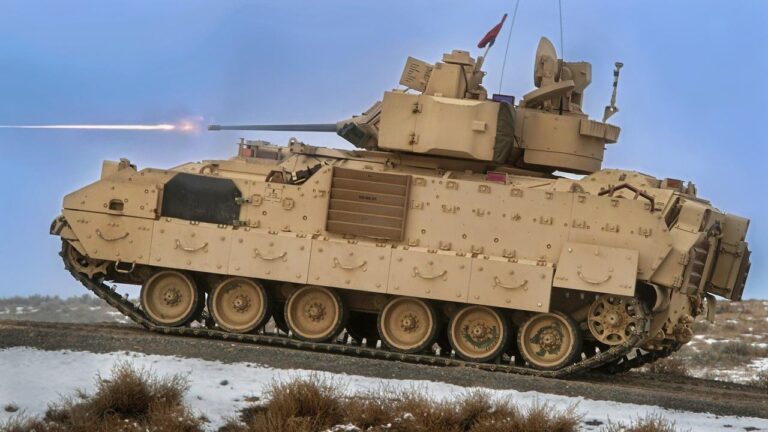An unexpected development has surfaced on the battlefield as a modified M2 Bradley Fighting Vehicle has been spotted in Russia, outfitted with a locally manufactured 30mm cannon. This unprecedented adaptation marks a significant departure from the Bradley’s traditional American armament, raising questions about the origins, intended use, and tactical implications of the altered armored vehicle. Analysts and military observers are now closely examining the appearance of the modified Bradley, seeking to understand the impact this could have on ongoing conflicts and armor warfare dynamics.
M2 Bradley Fighting Vehicle Spotted in Russian Service Equipped with Indigenous 30mm Cannon
The recent sighting of the M2 Bradley Fighting Vehicle in Russian service marks a remarkable twist in modern mechanized warfare. Unlike its original American configuration, the Bradley spotted has been refitted with a domestically produced 30mm cannon, a modification that underscores Russia’s evolving approach to armored vehicle armaments. This upgrade likely aims to enhance the vehicle’s firepower while maintaining compatibility with the Bradley’s existing turret and fire control systems, allowing Russian forces to leverage a proven platform with localized manufacturing advantages.
Experts speculate that the choice of an indigenous 30mm weapon could be motivated by logistical convenience, ensuring easier maintenance and ammunition supply within Russian theaters of operation. The modification may also open pathways for further upgrades, such as incorporating domestic targeting pods or active protection systems, turning the Bradley into a hybrid platform tailored for Russia’s operational demands.
- Caliber: 30mm (Russian-made)
- Base Model: M2 Bradley Fighting Vehicle
- Possible Enhancements: Fire control adaptation, ammunition compatibility
- Deployment: Reported in active Russian service zones
| Feature | Original M2 Bradley | Russian Variant |
|---|---|---|
| Main Cannon | M242 Bushmaster 25mm | Indigenous 30mm Autocannon |
| Fire Control | American System | Modified for Local Ammo |
| Armor | Steel and Composite | Unchanged |
| Role | Infantry Fighting Vehicle | Infantry Fighting Vehicle with Enhanced Firepower |
Analysis of the Locally Manufactured Cannon’s Impact on Bradley’s Combat Capabilities
The integration of a locally manufactured 30mm cannon onto the M2 Bradley significantly redefines its battlefield role, potentially impacting both firepower and logistical dynamics. While the original Bradley’s armament is centered around the Bushmaster autocannon, the adoption of a domestically produced weapon could enhance self-reliance and simplify maintenance due to easier access to parts and local expertise. However, this shift may come with trade-offs in terms of ammunition compatibility and ballistic performance, which remain under close scrutiny by defense analysts. The locally made cannon’s rate of fire, muzzle velocity, and effective range suggest competitive performance, but questions linger on durability and long-term operational reliability under combat conditions.
Beyond raw specifications, the tactical implications are paramount. The new cannon may offer improved adaptability against evolving threats, such as enhanced armored targets or low-flying drones, due to possible modifications unique to the local design. Additionally, the psychological effect of fielding an indigenous weapon system cannot be understated; it symbolizes a strategic leap toward autonomous defense capabilities. The table below summarizes key comparative factors influencing Bradley’s combat readiness after this modification:
| Feature | Original Bushmaster | Locally Made 30mm Cannon |
|---|---|---|
| Rate of Fire | 200-300 RPM | 220-280 RPM |
| Caliber | 30x173mm | 30x165mm |
| Effective Range | 1,500 meters | 1,400 meters |
| Ammunition Types | AP, HEI, TP | AP, HEI (locally produced) |
| Maintenance | Requires imported parts | Fully local support |
Recommendations for Western Military Observers to Monitor Upgrades and Tactical Deployments
Western military analysts should prioritize comprehensive surveillance of Russian armored vehicle upgrades, especially those involving unexpected local adaptations like the 30mm cannon spotted on the M2 Bradley platform. Close examination of deployment patterns across conflict zones will help identify whether these modifications are isolated experiments or indicate a broader doctrinal shift in mechanized warfare. High-resolution satellite imagery combined with signals intelligence can provide crucial insight into unit rotations, training exercises, and logistical movements associated with these retrofitted vehicles.
Key focus areas for observers include:
- Tracking serial number variations and hull markings to trace production batches
- Monitoring electronic warfare suites and communications equipment paired with the upgraded weapon systems
- Analyzing battlefield integration alongside other combined arms components
| Observation Medium | Utility | Expected Outcome |
|---|---|---|
| Satellite Imagery | Visual confirmation of vehicle markings and deployment zones | Identification of unit locations and upgrade spread |
| Signal Intercept | Monitor command communications near upgrade sites | Understanding operational intent and coordination |
| OSINT Analysis | Cross-check imagery It looks like your table got cut off at “Cross-check imagery”. Would you like me to help you complete or enhance the OSINT Analysis row and possibly finish the table? Let me know how you’d like to proceed!
Final ThoughtsThe appearance of the M2 Bradley Fighting Vehicle equipped with a locally produced 30mm cannon in Russia marks a significant development in the evolution of armored combat capabilities. As details continue to emerge, analysts will be closely watching how this adaptation influences both tactical deployment and broader military strategies. This latest modification underscores the ongoing efforts to modernize existing platforms amid shifting defense priorities and resource constraints. The War Zone will continue to monitor the situation and provide updates as more information becomes available. |




